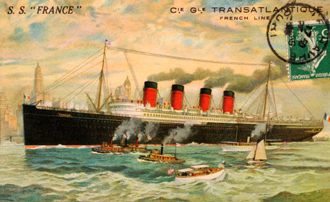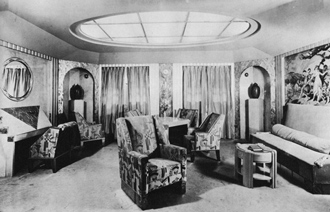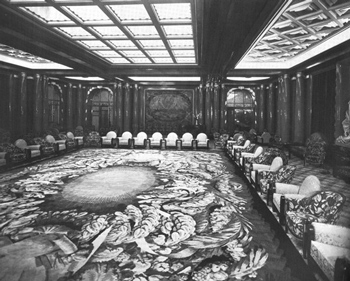A Luxurous French Ship Rescues Andrea Doria and Outlasts WWII

Ile de France under full steam. Credit: National Archives
The Ile de France was one of many ships, not including military ones, that became unsung heroes during WWII. Unfortunately many became victims of German U-boats or losers in battles at sea. But not this one, not the long-lasting SS Ile de France. A French vessel, she was built by a French line at a cost of $10 million. She was the first French liner built after WW I and launched March 14, 1926. At seven hundred feet long and 44,356 tons, the impressive liner left the shipyard with much respect from onlookers and an up-close view that was breathtaking.
Her maiden voyage from Le Havre, France, to New York received a gala welcome in the Big Apple where its 1,365 total passenger capacity celebrated well into the night. One of the largest passenger liners, the “Ile” was considered one of the most handsomely decorated liners of its day. Her accommodations were designed on a theme of the present and future, not by the past which other liners clung to and were reluctant to change. One of her innovations was indirect lighting throughout the ship. French artisans decorated her interior. Art deco was introduced with modernistic designs that were catching on in Europe and the United Staes. The roomy cabins were only over-shadowed by a main sitting salon that looked large enough to hold any club or council group.
The food and all the ships’ trappings were so good they drew celebrities such as Lena Horn, Rita Hayworth, Cary Grant, Maurice Chevalier and Prince Rainer of Monaco. Other attractions included a 100-seat chapel, a shooting gallery, a 60-car garage, an indoor swimming pool, a bowling alley, a merry-go-round, a 350-seat theater and a state of the art gymnasium. All of these amenities could be had for $1,800 per person first class which would be $54,000 today for the one-week crossing.
The ship was popular especially among wealthy Americans and quickly became the chosen ship of the youthful, the stylish, and the famous. This success continued until September 1939 when the Ile de France was the last civilian ship to leave France before the outbreak of war. She departed from Le Havre on the morning of September 3, 1939, just hours before France and the United Kingdom declared war on Germany, arriving in New York on September 9, 1939.

The rooms were spacious aboard the luxury liner. Credit: Cunard Lines
She remained inactive in New York until March 1940 when the Ile was loaned to the British Admiralty where she was stripped of her beautiful interiors and refitted with 9,705 berths ready and waiting for the troops. In addition to the troops, she was loaded with 12,000 tons of war materials including tanks, shells and several uncrated bombers stored on the open aft deck. In May, 1941 when she was decorated in wartime gray and black, the ship departed for Europe. From there she sailed to Singapore where the British put her into the heart of the war. She served honorably in her major responsibility, transporting thousands of soldiers to their assignments. In one crossing from the United States to the United Kingdom, she was in a convoy where 16 ships were hit or sunk by German U-boats. The skillful and experienced Captain of the Ile avoided the torpedoes and gunfire to make the crossing safely. The early war years, 1942-1943, were rough on U.S. and Allied ships. But anti-submarine progress considerably cut back on losses and boosted the fighting men’s morale.
After the war, Ile de France was first used to ferry American and Canadian troops home. Then in April 1947, the ship returned to its builder’s yard at Saint Nazaire for a two-year restoration. Upon completion, she travelled to New York on her first postwar luxury crossing in July 1949. Once again, the Ile de France proved to be just as popular as before the war.

Fancy salon could hold large group gatherings. Credit: Cunard Lines
And again, on July 26, 1956, she had a major role in the rescue operation after the collision of the passenger liners Andrea Doria and Stockholm off Nantucket. The Ile served gallantly to help save passengers aboard the Andrea Doria, the first passenger liner built to run the North Atlantic after WWII. Named after a Genoa admiral, the luxury liner entered service between Genoa and New York on July 25, 1953, after making stops at Cannes and Naples. On July 19, 1956 the pride of Italian passenger vessels departed Genoa on her 51st crossing of the Atlantic and by the evening of the 25th she was cruising at a fast pace through the foggy approach to Nantucket Sound when she was rammed by the Swedish-American line’s passenger ship Stockholm which was outward bound from New York. Although the Stockholm had appeared on Andrea Doria’s radar screen, no effort was made to take evasive action until it was too late. The Stockholm knifed into the other ship’s starboard side instantly killing 43 passengers and crew. A watertight bulkhead was also destroyed causing the Andrea Doria to begin leaking severely. As if this wasn’t enough, she was unable to launch her starboard side lifeboats. The Captain issued a distress call and soon more than 1,000 passengers and crew, survivors of the collision, had been taken aboard the Ile de France. When everything was over, a settlement out of court was made and the Ile received praise for her role in the rescue.
Side notes about the Ile include: In 1936 she was immortalized by the song “A Fine Romance,” which Fred Astaire and Ginger Rogers danced to in the film “’Swing Time” with the lyric: “You’re just as hard to land as the Ile de France. (Astaire trying to woo Rogers). In 1949, the ship was the setting for the Broadway musical “Gentlemen Prefer Blondes” and later rented out to a Hollywood film company for “The Last Voyage.”
The heroic Ile de France, named after an island of the Seine River, left this world with no fanfare. Taken out of service in 1959, she left Le Havre for Japan where she was scrapped.
Author: Ellsworth Boyd
Ellsworth Boyd, Professor Emeritus, College of Education, Towson University, Towson, Maryland, pursues an avocation of diving and writing. He has published articles and photo’s in every major dive magazine in the US., Canada, and half a dozen foreign countries. An authority on shipwrecks, Ellsworth has received thousands of letters and e-mails from divers throughout the world who responded to his Wreck Facts column in Sport Diver Magazine. When he’s not writing, or diving, Ellsworth appears as a featured speaker at maritime symposiums in Los Angeles, Houston, Chicago, Ft. Lauderdale, New York and Philadelphia. “Romance & Mystery: Sunken Treasures of the Lost Galleons,” is one of his most popular talks. A pioneer in the sport, Ellsworth was inducted into the International Legends of Diving in 2013.
1 Comment
Submit a Comment
All Rights Reserved © | National Underwater and Marine Agency
All Rights Reserved © | National Underwater and Marine Agency
Web Design by Floyd Dog Design
Web Design by Floyd Dog Design

Thanks Mr. Boyd for such an enjoyable article on the service record of the Ile de France. She must have been consistently maned by an outstanding crew and command staff to have been involved in so many activities and rescues–a remarkable achievement! Sad ending for a craft of such outstanding service.